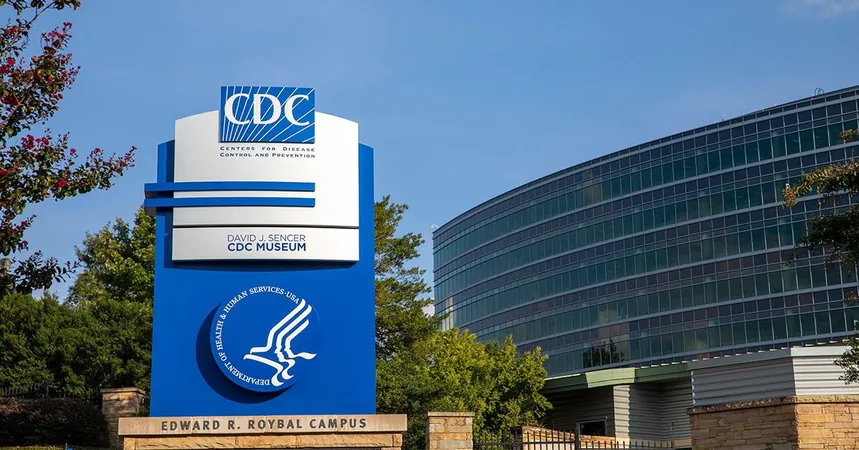
COVID-19 Aftermath: STIs in the U.S. Show Signs of Stabilizing, But Are We Out of the Woods?
2024-11-15
Author: Amelia
The latest statistics from the Centers for Disease Control and Prevention (CDC) suggest that rates of sexually transmitted infections (STIs) in the United States may be stabilizing after decades of steady increase. While STIs remain at historically high levels, new cases of chlamydia are reported to have leveled out, and gonorrhea cases have seen a decline for two consecutive years.
In 2023, approximately 2.4 million cases of chlamydia, gonorrhea, and syphilis were documented in the U.S., with chlamydia accounting for a staggering 1.6 million cases. Gonorrhea cases dropped to around 600,000, and syphilis cases stood at 209,000. Although there has been a slight reduction in total STI cases, experts warn that substantial work still remains. The overall incidence of STIs declined by 1.8% between 2022 and 2023, which has prompted cautious optimism among health officials.
Disparities persist in STI prevalence among different demographic groups. Young adults aged 15 to 24, along with gay and bisexual men and Black individuals, continue to bear a disproportionate burden of these infections. Dr. Bradley Stoner from the CDC emphasizes that while there is a noteworthy decline in the acceleration of syphilis cases—showing only a 1% increase this year compared to previous years—this situation remains critical, with 2023 marking the highest number of syphilis cases since 1950.
The alarming trend of congenital syphilis, which occurs when the infection is transmitted from mother to child during pregnancy, remains in focus. In 2023, nearly 4,000 congenital syphilis cases were recorded, with tragic outcomes that included stillbirths and infant deaths. Experts underline the importance of prevention, asserting that congenital syphilis should not occur under accessible healthcare conditions.
While chlamydia and gonorrhea trends appear to show some positive signs, the reality is that a mix of declining condom use and gaps in sexual education may be contributing to these troubling rates. Many public health advocates argue that fostering open conversations about STIs is crucial to de-stigmatizing the issue, enabling more individuals to seek necessary testing and treatment.
Despite the slight downturn in gonorrhea cases, some medical professionals are concerned about the potential resurgence in STI rates as society rebounds from the COVID-19 pandemic. Notably, gonorrhea saw a 7.7% decrease from 2022 and a 9.2% reduction from 2021 to 2022, signaling a need for ongoing vigilance and proactive measures.
Experts recommend preventive strategies, including the use of barrier methods such as latex condoms and routine STI screenings, particularly amongst young adults. Dr. Jake Scott, a clinical associate professor at Stanford Medicine, notes that clear educational messaging on sexual health is pivotal.
The CDC's updated guidelines now also suggest that doctors discuss options such as Doxycycline post-exposure prophylaxis, which has proven effective for reducing rates of gonorrhea, chlamydia, and syphilis among high-risk populations.
It's essential for individuals, especially those with multiple partners or not using protection, to prioritize regular screenings as many STIs can be asymptomatic. As the landscape of sexual health debates continues to evolve, the focus on comprehensive education and accessible healthcare remains critically important for safeguarding public health.
While the trends offer some hope, the fight against STIs is far from over—and the health community is united in the mission to educate, innovate, and implement effective measures to combat this ongoing public health challenge.









 Brasil (PT)
Brasil (PT)
 Canada (EN)
Canada (EN)
 Chile (ES)
Chile (ES)
 España (ES)
España (ES)
 France (FR)
France (FR)
 Hong Kong (EN)
Hong Kong (EN)
 Italia (IT)
Italia (IT)
 日本 (JA)
日本 (JA)
 Magyarország (HU)
Magyarország (HU)
 Norge (NO)
Norge (NO)
 Polska (PL)
Polska (PL)
 Schweiz (DE)
Schweiz (DE)
 Singapore (EN)
Singapore (EN)
 Sverige (SV)
Sverige (SV)
 Suomi (FI)
Suomi (FI)
 Türkiye (TR)
Türkiye (TR)